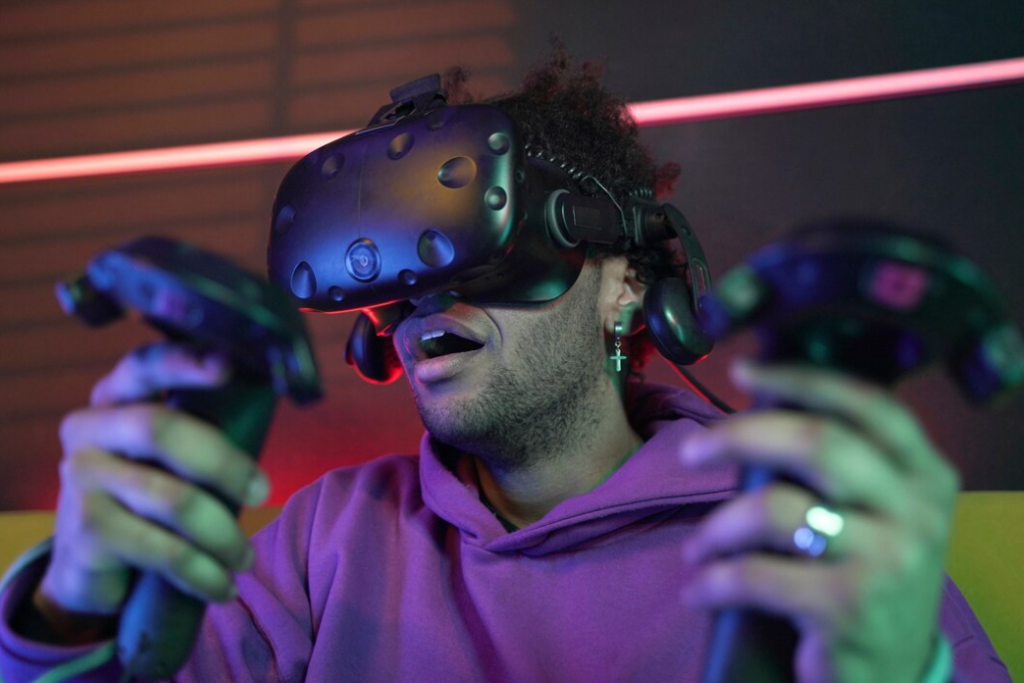Virtual reality has revolutionized the way we experience the world, offering limitless possibilities beyond physical constraints. With the global VR gaming market projected to reach $53.44 billion by 2028, it’s no wonder that many entrepreneurs aspire to enter this flourishing industry. However, standing out among the vast number of existing offerings is crucial. So, how challenging is it to create a VR game that truly captivates audiences?
To delve into the fundamentals and discover the best practices of VR game development, this article serves as your comprehensive guide. Get ready to explore the essentials and unlock the secrets to crafting an exceptional virtual reality experience.
Step-by-Step Guide to Building VR Games Effectively
Are you eager to learn the process of creating VR games that stay within budget and meet audience needs? This comprehensive article provides a step-by-step workflow to help you efficiently organize your VR game development process.
From Concept to Creation
Before diving into the development phase, thorough preparation is essential to save time and resources. Here’s a checklist of crucial steps to take:
- Generate a unique idea: Collaborate with the product owner and marketing specialists to analyze the VR gaming market and develop a concept that sets your game apart from competitors.
- Choose the platform: Research the most prevalent virtual reality headset among users to maximize your game’s potential player base. Careful analysis, such as considering sales data, can guide you in making an informed decision.
- Assemble a talented team: It’s crucial to have experienced professionals on board to avoid launch delays and costly mistake fixes. Consider options like outsourcing or hiring foreign experts with competitive rates to optimize your team composition.
- Create a game design document (GDD): Outline technical requirements, game logic, and visual concepts in a detailed GDD. This document serves as a roadmap for your developers, ensuring a cohesive and expected outcome.
- Develop a test design document: Testers should prepare a comprehensive strategy for quality control. This document includes technical information and testing tasks, enabling efficient testing once the initial code unit is ready.

By following this organized workflow, you can lay a solid foundation for your VR game development journey, setting yourself up for success in both meeting audience expectations and staying within your budget constraints.
Building a VR Game: From Theory to Action
Now that you have a solid grasp of the theoretical aspects of VR game creation, it’s time to translate that knowledge into practical application. The production phase is where your team will bring your game to life, and the workflow may vary depending on the chosen tech stack. Unity and Unreal Engine (UE) are two popular game engines commonly utilized for VR game development, each with its own unique strengths.
If your goal is to create a VR game as a mobile application, Unity is a suitable choice. It offers a robust set of tools and is widely used for developing virtual reality experiences on mobile platforms. On the other hand, Unreal Engine is renowned for its exceptional visual quality and is often preferred for creating VR games on consoles and desktop platforms.
Regardless of the game engine chosen, the key stages of building a VR game remain similar to any software development process. 3D modeling artists will create the visual content, including environments, characters, and props, and animate them to meet the game’s requirements. Both Unity and Unreal Engine provide marketplaces with a wide selection of pre-made assets, enabling you to customize and integrate them seamlessly into your game.
Following that, the back-end work commences, where the visuals and actions are combined according to the script and translated into code. Game engines like Unity and UE offer various tools and software development kits (SDKs) to simplify the creation of a rich and immersive VR environment. Thorough testing is crucial, employing unit testing methods, to identify and rectify any bugs or issues present in the code.
The Testing Process in VR Game Development
Once developers have confidence in their code, testers come into action with their arsenal of testing techniques and tools to thoroughly assess the functionality and durability of the game across various scenarios. When it comes to testing VR games, specialists meticulously search for bugs and unexpected behavior that may arise during user interaction, providing valuable feedback to developers for necessary fixes.
After rigorous testing and ensuring a game’s impeccable functionality and user experience, it is finally ready to be launched in the market. However, the development team’s journey is far from over. The relentless pursuit of excellence continues as developers constantly strive to enhance the product and maintain its high quality. New features are introduced, while testers diligently perform regression testing to ensure that modifications to individual units do not compromise the overall stability and integrity of the code.
5 Key Best Practices for Building VR Games
It is a well-known fact that every process has its most effective approaches. Typically, gaining knowledge about helpful specifics is a result of experience, involving numerous mistakes that lead to discovering optimal solutions for specific tasks.
Fortunately, in the age of the internet, one can save valuable time by not having to independently master game development, as many experts generously share their knowledge for free. Consequently, the experts at Game-Ace have identified the top five tips for aspiring VR game developers and more.

- Prioritize a high level of interactivity. While it may seem like common sense, VR games require a particular emphasis on interactivity. Since VR technology aims to provide an unparalleled experience, gamers should feel fully immersed in a realistic world where objects that appear interactive actually behave as such.
- Account for VR limitations. It’s fantastic to have brilliant ideas for a VR project, but it’s essential to ensure they align with the capabilities of virtual reality. Put simply, mechanics and gameplay that work well for desktop games may not be suitable for VR headsets.
- Avoid overly complex level designs. Navigating a fully immersive and unfamiliar environment can be more challenging than in a PC, mobile, or console game. Some users may experience anxiety if they can’t discern what they need to do or where to go next. Therefore, it’s advisable to create levels that are less intricate than AAA games and provide additional hints for potentially confusing sections.
- Implement positional audio. Positional audio is a crucial element wherein sounds originate from their intended sources. Adjust the audio in a way that corresponds to the player’s distance and position relative to the sound object, enhancing immersion and creating a more realistic impression.
- Conduct thorough real-life testing. VR games engage most of the human senses, making it vital to test the game using an actual headset. Evaluate not only the gaming user experience but also the user’s physical well-being. If a tester experiences motion sickness after only 10 minutes of gameplay, it indicates a problem that needs fixing, whether it’s related to camera settings or mechanics.
VR Game Development Process: Insights from Professionals
When it comes to VR game development, partnering with a professional company that offers outsourcing or outstaffing services can be a valuable solution, especially if you’re new to the field or lack the necessary resources to efficiently organize your process. This approach brings several benefits, including:
- No recruitment hassle: By collaborating with a specialized company, you can skip the recruitment process and gain access to a team of pre-vetted specialists who are already employed by the outsourcing company.
- Access to hardware and software: Outsourcing companies have all the essential hardware and software required for efficient VR game development. This saves you the time and effort of acquiring and setting up the necessary equipment yourself.
- Cost savings: Opting for outsourcing can result in significant cost savings. You can avoid expenses such as full-time salaries, paid time off, employee benefits, office rent, and training for in-house employees. Outsourcing allows you to tap into the expertise of professionals without the financial commitment of a full-time team.
If you’re looking for a reliable partner to alleviate the burdens of VR development, Game-Ace is an excellent choice. With 17 years of experience, we are a professional and innovative game creation studio. Our expertise lies in Unity and Unreal Engine, and we specialize in designing next-generation VR games that offer players an exceptional gaming experience.
FAQ
Q: How much does it cost to build a VR game?
A: The development time and cost of a VR app or game can vary depending on its complexity. For simpler VR experiences, such as basic games or apps, it can take around one to two months to develop, with costs starting at around $20,000. On the other hand, VR projects of medium complexity, such as creating an online store with VR capabilities, may require up to six months of development time and have costs starting from $30,000. It’s important to note that these are general estimates, and the actual time and cost can vary based on the specific requirements and features of the VR project.
Q: What code is used to make VR games?
A: VR games can be developed using various programming languages and game engines. Commonly used languages for VR game development include C# for Unity, C++ for Unreal Engine, and JavaScript for web-based VR experiences. These languages provide the necessary tools and frameworks to create immersive and interactive VR gameplay mechanics.
Q: Can you make a VR game without coding?
A: While coding skills are typically beneficial for developing VR games, it is possible to create VR experiences without extensive coding knowledge. Game engines like Unity and Unreal Engine offer visual scripting tools that allow users to create VR games using a node-based system. These visual scripting tools provide a more intuitive interface where users can drag and drop pre-built components and scripts to create interactions, animations, and gameplay mechanics. However, for more complex and customized VR experiences, some level of coding may still be required.
Q: How long does it take to code a VR game?
A: The development timeline for a VR training program typically ranges from 8 to 10 weeks, although it can vary depending on the project. Some projects can be completed in as little as 4 weeks, while others may take as long as 6 months or more. The development time for VR content is influenced by several factors, including the creation of the flowchart and script. These initial stages are crucial for outlining the desired user experience and setting the foundation for development.